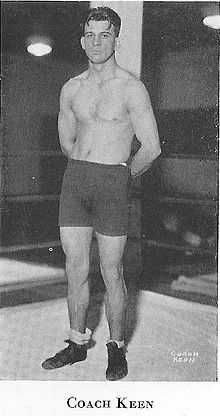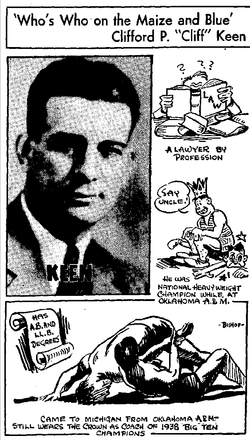Cliff Keen

Clifford Patrick Keen (June 13, 1901 – November 4, 1991) was an American coach who served as the head coach of the University of Michigan collegiate wrestling team from 1925 to 1970. He led the Michigan Wolverines to 13 Big Ten Conference championships, and coached 68 All-American wrestlers. In 1976, he was one of the initial inductees into the National Wrestling Hall of Fame.
Oklahoma A&M (Oklahoma State University)
Keen was born on a ranch in Roger Mills County, Oklahoma, near the town of Cheyenne.[1] He got his start in wrestling as a middleweight at Oklahoma A&M (now Oklahoma State University–Stillwater), where he became a national champion.[2][3] He was undefeated as a collegiate wrestler in weight divisions through the heavyweight class.[3][4] His wrestling coach at Oklahoma A&M was Edward C. Gallagher.[4] Keen was also a lineman for the Oklahoma A&M football team and a sprinter on the track team. He was named to the 1924 Olympic team but did not compete because of a broken wrist.[5] Keen graduated from Oklahoma A&M in 1924.[3]
Keen started his coaching career in 1925 as a high school football coach in Frederick, Oklahoma; his team outscored opponents 355 to 3.[4]
Wrestling coach at Michigan

Ironwood Globe, March 1939
After coaching in Oklahoma for a year, Keen took a job at Michigan as the wrestling coach and assistant football coach.[3] His teams won Big Ten championships in 1929, 1930 and 1938, and five of his teams in his first 12 years went through their seasons with a single defeat.[3] One of his first great wrestlers was Ed Don George, who later became the world’s heavyweight champion.[3]
As the wrestling coach at Michigan from 1925 to 1970, Coach Keen led the teams to a record of 268 wins, 91 losses, 9 ties and 13 Big Ten Conference wrestling championships.[6] His teams placed in the top three in the Big Ten 40 times. His wrestlers captured 11 National Collegiate titles and 81 conference crowns. In his 42 years at Michigan, he coached 68 All-Americans as well as 81 Big Ten champions. His teams once went undefeated for four years and 34 matches.[6][6]
His length of service as Michigan's wrestling coach was “the longest tenure of any coach in any sport in NCAA history.”[5]
He obtained a law degree from Michigan in 1933. Keen later said he had never intended to make a career of coaching, but wanted to go into law. He said: “I never intended to continue at coaching when I got my law degree here. But that was the depths of the depression and I needed a job. I kept saying I'd coach one more year. . . . I never expected it to last 45 years.”[2] Asked at the time of his retirement from coaching in 1970 if he would finally open his law practice, Keen joked, “I'm going into the full practice of retiring, I think.”[2] He took three years off from coaching to serve as a Naval Commander during World War II.[2] “When I came out of the service I definitely, positively decided I had to start my law practice, but Fritz Crisler persuaded me to keep coaching.”[2]
Keen was a firm believer in wrestling as a means to build character. He once said: “I believe that wrestling plays a highly educational part in the development of a boy. The fundamental that every successful wrestler must acquire, and which has great carry-over value after his student days, is self-discipline. From self-discipline stems self-confidence and belief in one's self. What greater lesson can a sport or a coach impart?"
Keen later recalled that one of the greatest moments of his career came in 1965, when his team threw a big surprise for him after the Big Ten meet. More than 200 of his former wrestlers attended, including the entire 1928 team that won the Big Ten championship.[2] Keen said, “I take a lot of pride in what these fellows have done, not only in wrestling, but later. They've been pretty successful in a number of things and the list reads like a ‘Who's Who.’ Whenever I think of that I get a lot of pride and satisfaction.”[2]
Keen also spent 33 years as an assistant football coach with the Wolverines, serving under head coaches Fielding H. Yost, Fritz Crisler and Bennie Oosterbaan. During Gerald Ford's football career at Michigan, from 1932-34, Keen coached Ford as the center on the offensive unit. In fact, Ford considered Keen “his coach” and maintained a friendship with Keen throughout his life.[7]
When Keen retired in 1970, the Associated Press reported: “Cliff Keen could have spent a career wrestling with law books. But instead he decided that wrestling itself was his ambition. That was back in 1925. Calvin Coolidge was president. Booze was illegal. Alexander J. Groesbeck was the governor of Michigan. And Cliff Keen became the University of Michigan wrestling coach. Forty-five years? How could anyone be a wrestling coach for 45 years.”[2]
Olympics and wrestling innovator
Keen also served on the U.S. Olympic Committee from 1928 to 1952 and was manager of the 1948 Olympic team in London.[4][6] He was an original member and later president of the National Wrestling Coaches Association and also presided over the national rules committee.[4]
For many years Keen pioneered the development of safe, effective, wrestling equipment such as the Cliff Keen head guard that bears his name.[4] He is credited with developing the wrestling headgear used to protect wrestlers from head and ear injuries.[6] And in 1955, Keen developed a new circular wrestling ring. At the time of its introduction, the Associated Press reported: “Michigan wrestling coach Cliff Keen saw his brainchild take shape this season – a circular wrestling ring. He has great hopes for it.”[8] The principle behind Keen's round ring was to eliminate the corners. Keen felt it was too easy for a wrestler to reach for the edge of the ring and pull himself out. The corners also restricted movement and made it difficult to maneuver from a corner, because a shift in either direction would put one or the other out of the ring.[8] Keen explained that the square ring was of “mechanical history.” With the ropes used in the 1930s, a square ring was needed because the ropes had to be anchored by posts. With the ropes gone from collegiate wrestling, Keen concluded it was time to free the sport of the squared ring.[8] In 1958 Keen founded the company Cliff Keen Athletic, which is still in the business of manufacturing wrestling gear, equipment and uniforms.[9] Keen was also one of the authors of Championship Wrestling, a leading book on wrestling technique for many years.
Honors and accolades
In 1976, Keen was one of five charter members of the National Wrestling Hall of Fame.[6] In 1980, he was inducted into the University of Michigan Athletic Hall of Honor as part of the third induction class. Only three University of Michigan coaches (Fielding H. Yost, Fritz Crisler and Ray Fisher) were inducted into the Hall of Honor before Keen.
Death and family
Keen died at age 90 at his home in Ann Arbor.[5] He was survived by a son, James Keen and a daughter, Joyce Novak. His wife Mildred Keen, and daughter Shirley (Keen) Leahy, preceded him in death.[5] His brother Paul V. Keen coached the University of Oklahoma wrestling team to a national championship.[2] Paul Keen followed his brother into the National Wrestling Hall of Fame in 1977.[10]
References
- ↑ Hammond, Jairus K., (2006). - The History of Collegiate Wrestling: A Century of Wrestling Excellence. - National Wrestling Hall of Fame and Museum.
- ↑ 2.0 2.1 2.2 2.3 2.4 2.5 2.6 2.7 2.8 AP wire service report (1970-02-05). "After 45 Years, Wolverines Wrestling Coach Will Retire". Ironwood Daily Globe.
- ↑ 3.0 3.1 3.2 3.3 3.4 3.5 "Who’s Who on the Maize and Blue: Clifford P. ‘Cliff’ Keen". Ironwood Daily Globe. 1939-03-25.
- ↑ 4.0 4.1 4.2 4.3 4.4 4.5 "National Wrestling Hall of Fame Profile: Clifford P. Keen". National Wrestling Hall of Fame.
- ↑ 5.0 5.1 5.2 5.3 AP wire service report (1991-11-06). "Former Michigan Wrestling Coaching Great Keen Dies". Tyrone Daily Herald (Pa.).
- ↑ 6.0 6.1 6.2 6.3 6.4 6.5 Courier News Service (1976-08-22). "McCuskey makes mat Hall of Fame". Waterloo Courier.
- ↑ Abbot, Gary (2007-01-07). "Wrestling legend Cliff Keen was coach and friend to late President Gerald Ford". USA Wrestling.
- ↑ 8.0 8.1 8.2 Barbour, John (1955-01-20). "U-M Uses Round Wrestling Ring". Ironwood Daily Globe.
- ↑ "About Us". Cliff Keen Athletic. Retrieved November 4, 2011.
- ↑ "Koll, Leeman in second Hall of Fame class". Waterloo Courier. 1977-08-21.
External links
| |||||
| |||||
| |||||